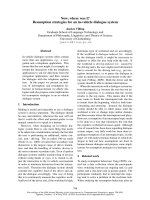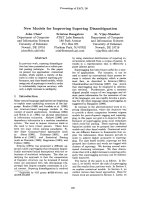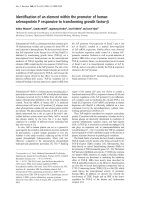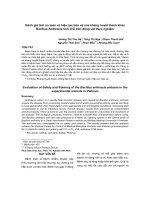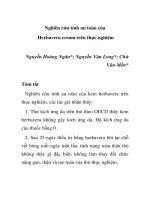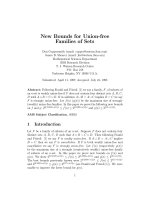Báo cáo y học: ":New tricks for an old-favorite model" pps
Bạn đang xem bản rút gọn của tài liệu. Xem và tải ngay bản đầy đủ của tài liệu tại đây (165.09 KB, 3 trang )
Rallis: Genome Biology 2009, 10:315
Abstract
A report of the 24th International Conference on Yeast Genetics
and Molecular Biology, Manchester, UK, 19-24 July 2009.
The international yeast meetings are highly interactive
conferences attracting scientists from diverse disciplines of
fungal research. The 24th yeast meeting held in the
University of Manchester presented recent advances rang-
ing from basic cell biology to the use of yeast for industrial
purposes and translational research. Here, I summarize a
few highlights related to systems and synthetic biology,
yeasts as model organisms in gene expression, aging and
human disease studies and the use of yeast cells as factories.
Yeast as model organism for aging studies
and human disease
Dennis Thiele (Durham University, North Carolina, USA)
uses Saccharomyces cerevisiae as a model organism for
studying metal metabolism. Iron is an essential micro-
nutrient for almost all living organisms, serving as a
co factor for a huge variety of cellular processes. Iron
imbalance is the primary nutritional disorder in the world
(affecting around 2 billion people); however, cellular
responses to iron deprivation are poorly understood. In
res ponse to iron deficiency, S. cerevisiae Cth2, an RNA-
binding protein conserved in plants and mammals, is
upregulated 200-fold. Cth2 binds to specific AU-rich
elements in the 3’ untranslated region of mRNAs and
causes their degradation. Interestingly, degradation takes
place in cytoplasmic processing bodies. Localization of
Cth2 is a dynamic process: Cth2 travels to the nucleus
before transcripts are delivered to processing bodies, and it
interacts with target transcripts at or soon after their trans-
cription. Microarray analysis for cells grown in low iron
supply (simulating iron deficiency) have revealed mRNAs
down regulated by Cth2, showing a global metabolic
reprogramming driven by a posttranscriptional regulatory
process controlled by iron deficiency.
Target of rapamycin (TOR) is the central component of a
conserved eukaryotic signaling pathway that regulates cell
and organismal growth in response to nutrient status.
Growth rate correlates with ribosome number and metabo-
lism, and TOR-dependent growth control in yeast and
Drosophila involves transcriptional regulation of ribo-
somal and metabolic genes. Suppression of the Drosophila
TOR pathway results in prolonged pre-adult development
and reduced larval and adult body sizes. TOR is linked to
aging from yeast to mammals and deregulation of the
pathway causes disease in humans (such as cancer, cardiac
hypertrophy and inflammatory diseases). Mike Hall
(Biozen trum, University of Basel, Switzerland) discussed
recent findings of his group regarding the cross-talk
between TOR with the protein kinase A (PKA) signaling
pathway, which controls many similar processes. They
established a pathway that includes a series of kinases,
such as Sch9, in which TOR is upstream of PKA. Never-
theless, there are PKA targets that are TOR independent.
Analysis showed that TOR is upstream of about half of the
targets of the PKA pathway.
Replicative lifespan refers to the number of daughter cells
a mother gives rise to before senescence. S. cerevisiae cells
have limited replicative lifespan and show similar declining
survival curves to those of metazoan cells. Longevity has a
heritable basis, and epigenetic changes through the
sirtuins, a group of deacetylases, have an important role in
lifespan regulation. Sir2 promotes increased replicative
lifespan, but the molecular basis of its action is poorly
understood. Shelley Berger (The Wistar Institute, Phila-
delphia, USA) focused her talk on yeast Sir2, which
removes lysine 16 from histone H4, promoting chromatin
silencing. Old cells have decreased levels of Sir2 protein
and of histone H4 lysine 56 acetylation, and H4 lysine 16
acetylation is increased. Sir2 antagonizes the action of Sas2
(a histone acetyltransferase) in subtelomeric regions, and
telomeric silencing is reduced in old cells. This mechanism
could represent an evolutionarily conserved function of
sirtuins in regulation of replicative aging by maintenance
of intact telomeric chromatin.
Systems and synthetic biology
Whole-genome duplication during evolution is common
and provides novel genetic material as a major source of
innovation and evolution. Nevertheless, it has been
calculated that in fungi around 85% of duplicated genes
have been lost. Evidence shows that genes encoding
transcription factors and signal transducers are the best
survivors following duplication. The reasons for this could
Meeting report
New tricks for an old-favorite model
Charalampos Rallis
Address: University College London, Department of Genetics, Evolution & Environment and UCL Cancer Institute, Darwin Building, Gower
Street, London WC1E 6BT, UK. Email:
315.2
Rallis: Genome Biology 2009, 10:315
be subfunctionalization (division of the original gene’s
functions between the duplicates), neofunctionalization
(gain of new functions by duplicates), advantages gained in
dosage balance in protein complexes or the need for
increased dosage. Greg Amoutzias (University of Gent and
Flanders Interuniversity Institute for Biotechnology (VIB),
Gent, Belgium) presented a careful approach based on
bioinformatics and a large phosphoproteomics dataset.
The ancestral phosphorylation is linked to gene retention
in future lineages. Statistical analysis showed that up to 7%
of duplicated genes have been subfunctionalized. Reciprocal
loss of ancestral phosphorylation sites and the gain of new
ones are major contributors in the retention of the two
surviving duplicates and in their acquisition of distinct
functions. Increasing the number of phosphorylation sites
increases the probabilities of both subfunctionalization
and survival in future generations. Duplicated genes and
their protein products are under tight regulatory control -
for example, by the proteasome.
Protein interactions underpin the genetic landscape. Kinases
and phosphatases dynamically regulate most cellular
processes, but because of the weak and transient inter-
actions taking place, a kinase interactome has not been
defined. Mike Tyers (University of Edinburgh, UK)
presented a newly developed screen for weak interactions
in budding yeast of all kinases and most of the
phosphatases using multiple tags and nanoscale liquid
chromatography-mass spectrometry. Low-confidence
interactions were removed by a novel statistical algorithm
that acts as a filter for large mass spectrometry datasets.
His group uncovered 1,844 statistically significant inter-
actions for 118 kinases, with more than 70% of them being
confirmed using co-immunoprecipitation. Tyers provided
examples of novel connections between signaling path-
ways, transcription-associated kinases, novel function of
uncharacterized cell cycle checkpoint kinases and new
effector kinases for the nutrient-responsive TOR signaling
pathway. It was apparent that the kinome interlinks the
proteome and that cellular behavior may be coordinated by
a global signaling architecture.
Yitzak Pilpel (Weizmann Institute of Science, Rehovot,
Israel) discussed adaptive environmental conditioning in
micro organisms, a situation similar to Pavlovian neuronal/
cognitive conditioning. Escherichia coli encounters various
metabolic environments in the digestive tract. The energy
source early in the digestive tract is lactose, leading to
activation of lactose operons, whereas later it is changed to
maltose, which activates a different set of genes (maltose
operons). Pilpel’s group found that maltose operons are
conditioned by lactose so that an intermediate level of
maltose gene expression is achieved by lactose, whereas
the converse situation is never observed. E. coli cells
primed with lactose survive better in maltose than those
that have not experienced lactose, and the expression of
maltose genes is costly to the organism. These results show
that E. coli tries to predict the change in the environment
and programs genetic circuits for a better response and an
increased chance of survival. Pilpel then moved to S.
cerevisiae, where he showed that similar conditioned
responses take place: oxidative protective genes are
induced following mild heat shock (a cross-protection
mechanism), but they are needed only in oxidative stress
conditions, as shown by the fact that deletion mutants
show the same survival as wild-type cells under heat shock.
Fritz Roth (Harvard University, Cambridge, USA) presen-
ted recent advances from his laboratory using parallel
high-throughput sequencing (Solexa) and barcode fusion
genetics for mass characterization of S. cerevisiae double
mutants in competitive grown pool assays (a technique
called BFG-GI). The technique involves the construction of
double mutants, as for the traditional synthetic genetic
array (SGA) approach, which are brought together in a
huge pool. Cells are suspended in water-in-oil emulsion
and are thus encapsulated within single droplets so that
the barcode fusion PCR that follows binds together
barcodes only from the same cell. Following emulsion
purification and Solexa sequencing, Roth’s group obtained
1.5 million mapped fused barcodes. Future efforts will also
focus on adapting the system for protein interaction assays.
Yeasts as cell factories
Diethard Mattanovich (Universität für Bodencultur, Vienna,
Austria) introduced the concept of systems bio technology
(applied research and development of microorganisms) and
described the use of the methylo trophic yeast Pichia
pastoris in metabolic engineer ing for the production of
proteins (human antibodies) by secre tion. The P. pastoris
genome is fully sequenced and available through an open
access genome browser [],
DNA microarrays and a proteo mics platform have been
developed and metabolic model ing and flux analysis are
currently being carried out. The Mattanovich group showed
that temperature has a great effect on the secretion of
heterologous proteins: a decrease in temperature results in
an increase in secretion. Proteome analysis revealed that
amino acid metabolism and ribosome biogenesis are
elevated whereas chaperones and TCA (tricarboxylic acid)
cycle enzymes are decreased. Transcriptome analysis
showed that genes associated with translation and ribosome
biogenesis are increased but stress response and TCA cycle
genes are downregulated. Metabolomics analysis indicates
that carbon metabolism is pushed towards biomass
production instead of energy production. Overall, the results
indicate that increased secretion could be a positive side-
effect of lowered energy demands. Mattanovich also
presented screens for the generation of improved production
strains. In one of these screens six novel secretion helper
factors were identified, all of them cytosolic and
endoplasmic reticulum chaperones.
315.3
Rallis: Genome Biology 2009, 10:315
Strain engineering is used in industrial biotechnology for
the generation of sustainable technologies in the produc-
tion of fuels, chemicals and materials. S. cerevisiae is
tolerant of ethanol and low pH, is prone to contamination
and shows robust aerobic and anaerobic growth. In order
to achieve methods that make efficient use of resources
without creating excess waste (eco-efficient methods),
pentose sugars (such as xylose) need to be used as they are
cheap, widely available in nature and can be obtained from
plant and waste sources. However, S. cerevisiae cannot use
pentoses. Genomic resources from a variety of micro-
organisms and systems biology combined with muta-
genesis have been used to engineer yeasts for effective
pentose fermentation. Merja Penttilä (VTT Technical
Research Centre of Finland, Helsinki, Finland) presented
the tremendous efforts being made towards alternative
sugar utilization from yeast. S. cerevisiae strains that
express xylose pathway genes from Pichia stipitis are
making pentose fermentation to ethanol a reality. In
addition, unconventional yeasts (such as Pichia, Candida
and Hansenula) are attractive production hosts owing to
their broader substrate range and tolerance to high
temperatures and low pH. Overall, this research will result
in consolidated and cost-effective processes that will
efficiently compete with petrochemistry.
Control of gene expression
Frank Holstege (University Medical Center, Utrecht, The
Netherlands) described the efforts of his group towards
the generation of genome control maps in S. cerevisiae.
These are exhaustive wiring diagrams that describe in
detail the contribution of regulatory factors for the
regulation of every single gene. In order to increase the
throughput of the mass microarray analysis used, they
have robotically automated their procedures. Using
external control cali bra tion standards to assess
improvements, the accuracy, precision and reproducibility
of the microarray technology have greatly been improved.
He presented examples of results following the expression
profiling of 800 compo nents of the regulatory machinery,
such as the discovery of protein complexes that were also
predicted from mass spectrometry data and an improved
understanding of signaling pathways from uncovering the
profiles for kinases and phosphatases and the complexity
of the ubiquitin machinery.
Brenda Andrews (University of Toronto, Canada) intro-
duced a fluorescent reporter SGA (R-SGA) experimental
approach in which a promoter-green fluorescent protein
(GFP) reporter along with a control promoter-red fluores-
cent protein (RFP) have been systematically introduced
into SGAs. Fluorescence intensities from each reporter are
assayed from individual colonies using a scanning
fluorimager, and the ratio between GFP and RFP intensity
reveals double mutants that show differential GFP
expression. The system has been successfully used for
studies on cell-cycle regulation of transcription in S.
cerevisiae (GFP was driven by a cell-cycle-regulated
promoter). The study has revealed a new regulatory
pathway for controlling cell-cycle-dependent gene
expression through the repression of histone transcription.
The histone chaperone Rtt106 in combination with other
two chaperones, Asf1 and the HIR complex, create a
repressive chromatin structure in the histone H2A
promoter. The histone acetyltransferase Rtt109 relieves
this repression, and the bromodomain-containing protein
Yta7, which binds acetylated histones, is required for
proper localization of Rtt106 to the promoter and prevents
it from localizing to coding regions. This model was
proposed as the primary mechanism of cell-cycle
regulation of histone promoters.
Overall, the meeting reflected the divergent and highly
interactive and vibrant yeast community. The 26th Inter-
national Conference on Yeast Genetics and Molecular
Biology takes place in Poland on 11-16 July 2011.
Acknowledgements
I thank Singer Instruments Co. Ltd for providing funds towards
attending the meeting.
Published: 1 September 2009
doi:10.1186/gb-2009-10-9-315
© 2009 BioMed Central Ltd
